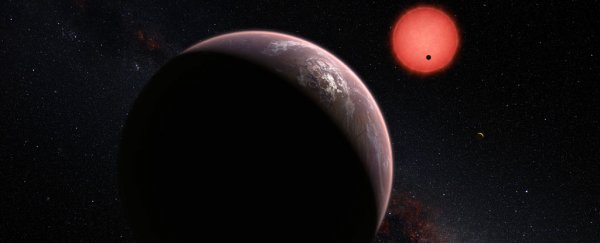An international team of astronomers has discovered three Earth-sized exoplanets, all orbiting the same star just 40 light-years from us, the 16-nation intergovernmental research organisation ESO reported on Monday.
The scientists have deemed all three planets potentially habitable, an exciting turn in the hunt for 'exoplanets', a term for planets that orbit a star other than our Sun. And it could bring us closer to finding extraterrestrial life.
Star systems like this are promising places to detect alien life, Michaël Gillon, lead author of the paper presenting the discovery, said in an ESO press release.
"If we want to find life elsewhere in the Universe, this is where we should start to look," he said.
The hunt for aliens
The host star is an ultracool dwarf star – a type of cool, red star. Most of the time these stars are too small and faint to be detected by optical telescopes, and this star is no exception.
"Why are we trying to detect Earth-like planets around the smallest and coolest stars in the solar neighborhood? The reason is simple: systems around these tiny stars are the only places where we can detect life on an Earth-sized exoplanet with our current technology," Gillon said.
The astronomers discovered the planets using a telescope in Chile called TRAnsiting Planets and PlanetesImals Small Telescope (TRAPPIST). The telescope is designed to focus on nearby dwarf stars and search for planets orbiting them.
Because light from the star is dimming at regular intervals, it suggests that several planets are orbiting it. The star is about an eighth the size of the Sun, half the temperature, and almost 2,000 times fainter. This is the first time astronomers have ever found any planets orbiting a star this small and dim.
Sweet spots
The scientists determined that the third planet, located farthest from its star, might be within the star's habitable zone.
Because of their closeness to the star, the other two planets are likely tidally locked, with one side always facing the star and the other always facing away.
Although the sides facing the star would be too hot to host any lifeforms and the sides facing away would be too cold and dark, the planets might contain 'sweet spots'. If the planets have atmospheres or even possibly oceans, heat from the star might be more evenly distributed, creating regions that just might be suitable for life.
"The kind of planets we've found are very exciting from the perspective of searching for life in the universe beyond Earth," Adam Burgasser, a professor of physics at the University of California San Diego's Centre for Astrophysics and Space Sciences, said in a press release.
Scientists will need to further study the planets to determine if they are actually capable of harbouring life.
One way they'll do this is by looking at the effect that the atmosphere of the planets has on the light reaching Earth. Because of the star's size and dimness, it won't drown out these planetary signals, allowing scientists to get a better look.
Scientists should eventually be able to study their composition and atmosphere more deeply as they look for signals of life.
"These planets are so close, and their star so small, we can study their atmosphere and composition, and further down the road, which is within our generation, assess if they are actually inhabited," coauthor Julien de Wit, a postdoc in the Department of Earth, Atmospheric, and Planetary Sciences, said in an MIT press release.
These findings open the door for future studies of other ultracool dwarf stars, which are long-lived and common in the Milky Way. Around three fourths of all stars and 15 percent of the stars near to the Sun are ultracool dwarf stars.
With the help of several giant telescopes that are under construction, de Wit says, scientists will soon be able to study the atmospheric composition of these planets to explore them for water and traces of biological activity.
The full results were published this Monday in the journal Nature.
This article was originally published by Business Insider.
More from Business Insider:
